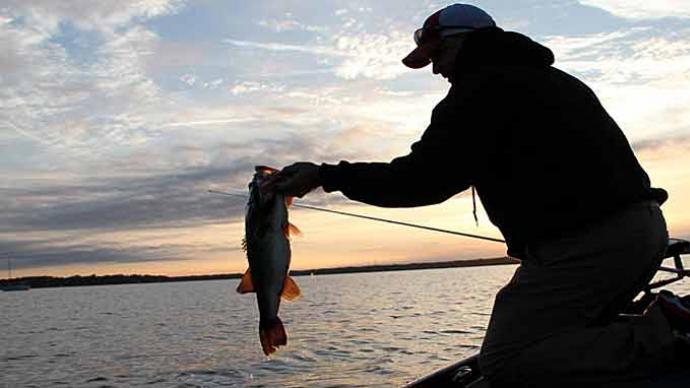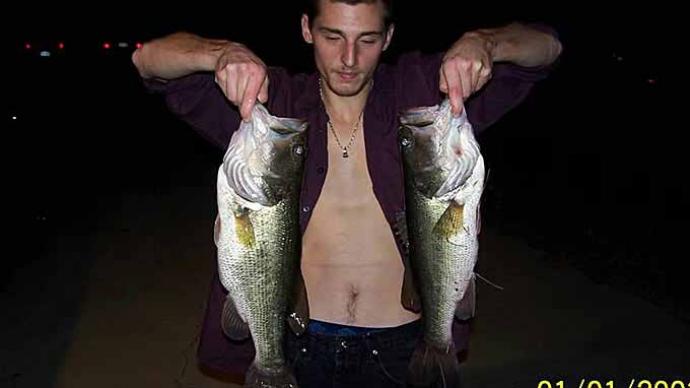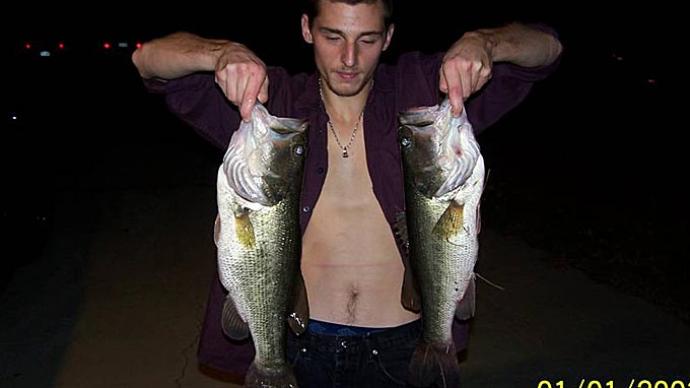| "As the evening deepens, fishing may become more somnolent, despite the frogs bellowing along the bank or the bats winging erratically. When the bites are few or far between, it's easy to close your eyes. But a striking bass, like a water moccasin on the front porch, rouses you instantly. You slide up on the edge of your seat and squeeze the foregrip of your rod with conviction -- primed to set the hook. Fingering the monofilament and holding the rod tip high, you feel something swat the line. You swing for the fences, only to find a bat -- not a bass -- has done you in." |
| --George Kramer |
Night fishing for bass is most commonly practiced in the deep, clear highland reservoirs of the southwest and the southeast, where daytime fishing during hot weather can be uncomfortable and unproductive. When bass go deep during the day, they can often be caught only by trolling in these lakes. However, bass often move up shallower at night, where they feed on nocturnal forage such as crawfish. Night fishing is fun but requires extra safety precautions. Be aware of obstacles and always wear your life jacket after dark.
When to Go
When the bass quit hitting during the daytime and when it becomes uncomfortably hot on the lake are good signals that it's time to start night fishing. Night fishing is usually practiced when the water is in the mid-60s and warmer.
Places to Fish
Where to fish at night is a question commonly asked by bass fishermen. In general, fish at night close to, but not on, the same places you caught fish earlier in the year. Bass don't move great distances in most situations. Smallmouth bass, especially, are proven stay-at-homes. If you found good fishing in a big creek arm during the spring, move to the first available deep water and look for structure such as a rock pile, channel drop-off, weed bed, etc.
As the summer wears on, the bass tend to move deeper and won't come up shallow, even at night, in many lakes. Night fishing is productive when the bass are within the 20-foot zone. Deeper than that, many fishermen find it hard to maintain contact with the lure and hook fish when they strike. Other places to try include:
- Shallow shorelines in natural lakes, especially close to weedbeds.
- Underwater roadbeds or other man-made structure in reservoirs.
- Gravel or rock banks where crawfish are abundant.
- Lighted boat docks.
Lures and Tackle
In general, many fishermen use heavier tackle at night than would be effective during the daytime in clear-water lakes. It's easier to "feel" a heavier lure at night than a light one, and it's easier to hook and land a big fish at night using stouter equipment. Here are some lures to try:
- Hair jigs and a plastic trailer - 3/8 ounce (smallmouths)
- Rubber jigs and a plastic trailer - 3/8 ounce or heavier (largemouths)
- Spinnerbaits - use a plastic trailer if desired.
- Plastic worms.
- Topwater lures, especially poppers, and wobblers.
For subsurface lures, contrasting dark colors (purple spinnerbait/red pork frog, etc.) prove effective after dark. For topwaters, black is the best choice in most situations, providing the most contrast to a fish looking upward. A constant retrieve is best for a topwater fished at night as it results in fewer missed strikes.
Other Equipment
Many bass anglers use "black lights" and fluorescent line when night fishing. Under the illumination of the black light, the fluorescent line glows like neon and makes subtle strikes easy to detect. However, other anglers avoid black lights, convinced they may spook some bass. Lures with more "feel," such as spinnerbaits, can be fished easily at night with or without a black light.
To avoid tangles and broken equipment, fishermen take only one or two rods/reels with them at night. Many use only single-hook lures such as spinnerbaits or jigs. Make sure your boat has working running lights. Carry a flashlight and be extra careful after dark.




